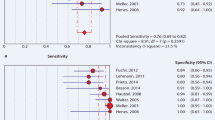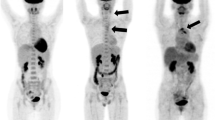Abstract
Large vessel vasculitis can be visualized by 18F-FDG positron emission tomography (PET). However, the diagnostic value of 18F-FDG PET is yet to be determined. We therefore performed a study to evaluate this technique for the diagnosis of giant cell arteritis (GCA) and Takayasu arteritis (TA). Patients with GCA or TA, who fulfilled the American College of Rheumatology (ACR) criteria and also had a pathologic PET scan in clinical routine, were selected. These PET scans, as well as PET scans obtained from age- and sex-matched control patients, were independently re-evaluated by two experienced nuclear medicine experts. PET scans of 20 patients (17 GCA, 3 TA) and 20 controls were evaluated. In 85% of the examinations, both observers agreed on the diagnosis or exclusion of vasculitis. Specificity was calculated with 80% and sensitivity with 65%, yielding an overall diagnostic accuracy of 72%. The mean maximum standardized uptake values (SUVmax) of the subclavian region was significantly higher in vasculitis than in control patients (2.77 ± 1.02 vs 2.09 ± 0.64; difference 0.69; CI95%: 0.14–1.24, p = 0.0161). SUVmax of the iliacal regions did not differ significantly. Receiver- operating characteristics (ROC) analysis revealed the highest sensitivity of 90% (CI95%: 68–99%) and specificity of 45% (CI95%: 23–69%) for a SUVmax cut-off point of 1.78 (AUC 0.72, (CI95%: 0.56–0.86). PET findings are reproducible and independent of the observer. The low sensitivity and specificity indicate that enhanced vascular uptake might be overrated if clinical details are suggestive for vasculitis. Therefore, the diagnosis of large vessel vasculitis should not be based on PET findings only.



Similar content being viewed by others
Notes
(1) Age 50 years or older, (2) new-onset localized headache, (3) temporal artery tenderness or decreased temporal artery pulse, (4) erythrocyte sedimentation rate of at least 50 mm/h, (5) abnormal artery biopsy specimen characterized by mononuclear infiltration or granulomatous inflammation [22].
(1) Age at disease onset in year ≤40 years, (2) claudication of extremities, (3) decreased brachial artery pulse, (4) difference of ≥10 mm Hg in systolic blood pressure between arms, (5) bruit audible on auscultation over one or both subclavian arteries or abdominal aorta, (6) arteriogram abnormality [23].
References
Andrews J, Al-Nahhas A, Pennell DJ, Hossain MS, Davies KA, Haskard DO et al (2004) Non-invasive imaging in the diagnosis and management of Takayasu’s arteritis. Ann Rheum Dis 63(8):995–1000
Scheel AK, Meller J, Vosshenrich R, Kohlhoff E, Siefker U, Muller GA et al (2004) Diagnosis and follow up of aortitis in the elderly. Ann Rheum Dis 63(11):1507–1510
Bruschi M, De LF, Govoni M, Roncali M, Prandini N, La CR et al (2008) 18FDG-PET and large vessel vasculitis: preliminary data on 25 patients. Reumatismo 60(3):212–216
Walter MA, Melzer RA, Graf M, Tyndall A, Muller-Brand J, Nitzsche EU (2005) [18F]FDG-PET of giant-cell aortitis. Rheumatol Oxf 44(5):690–691
Blockmans D, Stroobants S, Maes A, Mortelmans L (2000) Positron emission tomography in giant cell arteritis and polymyalgia rheumatica: evidence for inflammation of the aortic arch. Am J Med 108(3):246–249
Kobayashi Y, Ishii K, Oda K, Nariai T, Tanaka Y, Ishiwata K et al (2005) Aortic wall inflammation due to Takayasu arteritis imaged with 18F-FDG PET coregistered with enhanced CT. J Nucl Med 46(6):917–922
Hautzel H, Sander O, Heinzel A, Schneider M, Muller HW (2008) Assessment of large-vessel involvement in giant cell arteritis with 18F-FDG PET: introducing an ROC-analysis-based cutoff ratio. J Nucl Med 49(7):1107–1113
Webb M, Chambers A, Al-Nahhas A, Mason JC, Maudlin L, Rahman L et al (2004) The role of 18F-FDG PET in characterising disease activity in Takayasu arteritis. Eur J Nucl Med Mol Imaging 31(5):627–634
Andrews J, Mason JC (2007) Takayasu’s arteritis—recent advances in imaging offer promise. Rheumatol Oxf 46(1):6–15
Henes JC, Muller M, Krieger J, Balletshofer B, Pfannenberg AC, Kanz L et al (2008) [18F] FDG-PET/CT as a new and sensitive imaging method for the diagnosis of large vessel vasculitis. Clin Exp Rheumatol 26(3 Suppl 49):S47–S52
Blockmans D, De CL, Vanderschueren S, Knockaert D, Mortelmans L, Bobbaers H (2006) Repetitive 18F-fluorodeoxyglucose positron emission tomography in giant cell arteritis: a prospective study of 35 patients. Arthritis Rheum 55(1):131–137
Yun M, Yeh D, Araujo LI, Jang S, Newberg A, Alavi A (2001) F-18 FDG uptake in the large arteries: a new observation. Clin Nucl Med 26(4):314–319
Rudd JH, Myers KS, Bansilal S, Machac J, Pinto CA, Tong C et al (2008) Atherosclerosis inflammation imaging with 18F-FDG PET: carotid, iliac, and femoral uptake reproducibility, quantification methods, and recommendations. J Nucl Med 49(6):871–878
Meller J, Grabbe E, Becker W, Vosshenrich R (2003) Value of F-18 FDG hybrid camera PET and MRI in early takayasu aortitis. Eur Radiol 13(2):400–405
de Leeuw K, Bijl M, Jager PL (2004) Additional value of positron emission tomography in diagnosis and follow-up of patients with large vessel vasculitides. Clin Exp Rheumatol 22(6 Suppl 36):S21–S26
Janssen SP, Comans EH, Voskuyl AE, Wisselink W, Smulders YM (2008) Giant cell arteritis: heterogeneity in clinical presentation and imaging results. J Vasc Surg 48(4):1025–1031
Bertagna F, Biasiotto G, Rodella R, Giubbini R, Alavi A (2010) 18F-fluorodeoxyglucose positron emission tomography/computed tomography findings in a patient with human immunodeficiency virus-associated Castleman’s disease and Kaposi sarcoma, disorders associated with human herpes virus 8 infection. Jpn J Radiol 28(3):231–234
Stenova E, Mistec S, Povinec P (2010) FDG-PET/CT in large-vessel vasculitis: its diagnostic and follow-up role. Rheumatol Int 30(8):1111–1114
Blockmans D, Bley T, Schmidt W (2009) Imaging for large-vessel vasculitis. Curr Opin Rheumatol 21(1):19–28
Blockmans D, Coudyzer W, Vanderschueren S, Stroobants S, Loeckx D, Heye S et al (2008) Relationship between fluorodeoxyglucose uptake in the large vessels and late aortic diameter in giant cell arteritis. Rheumatol Oxf 47(8):1179–1184
Brodmann M, Lipp RW, Passath A, Seinost G, Pabst E, Pilger E (2004) The role of 2-18F-fluoro-2-deoxy-D-glucose positron emission tomography in the diagnosis of giant cell arteritis of the temporal arteries. Rheumatol Oxf 43(2):241–242
Hunder GG, Bloch DA, Michel BA, Stevens MB, Arend WP, Calabrese LH et al (1990) The American College of Rheumatology 1990 criteria for the classification of giant cell arteritis. Arthritis Rheum 33:1122–1128
Arend WP, Michel BA, Bloch DA, Hunder GG, Calabrese LH, Edworthy SM, Fauci AS, Leavitt RY, Lie JT, Lightfoot RW Jr et al (1990) The American College of Rheumatology 1990 criteria for the classification of Takayasu arteritis. Arthritis Rheum 33(8):1129–1134
Disclosures
None.
Author information
Authors and Affiliations
Corresponding author
Rights and permissions
About this article
Cite this article
Lehmann, P., Buchtala, S., Achajew, N. et al. 18F-FDG PET as a diagnostic procedure in large vessel vasculitis—a controlled, blinded re-examination of routine PET scans. Clin Rheumatol 30, 37–42 (2011). https://doi.org/10.1007/s10067-010-1598-9
Received:
Revised:
Accepted:
Published:
Issue Date:
DOI: https://doi.org/10.1007/s10067-010-1598-9




